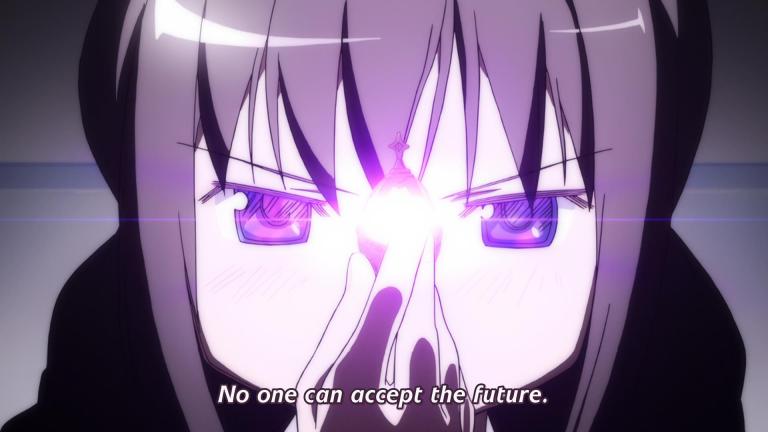Puella Magi Madoka Magica's Characters Represent the Five Stages of Grief
- SoVi
- Jul 15, 2018
- 4 min read
It is easy to see the complexity the show Puella Magi Madoka Magica offers when they discuss the issue of morality and justice. However, another interesting topic of this show is how the main magical girls are all representative of a stage in the five stages of grief which is seen with how they act toward the realization of death.
Before we begin the discussion we will need to understand what the five stages of grief is. The five stages of grief is a simplified version what a person goes through when they experience loss. It includes denial, anger, bargaining, depression, and acceptance. All of the stages are a part of the framework that makes up our learning to live with the one we lost. However, they are not experienced linearly or the same length of time. For this essay I will show how each girl represents a certain stage of grief and showcases what happens to a person if they fail or succeed to move on from that stage.
First, we then must discuss what loss the main characters are experiencing. In this case, this loss is themselves.
This reveals that the death that the characters are experiencing are themselves. However, the characters only begin their five stages of grief the moment they become a magical girl and when certain truth of what happens to magical girls is revealed.
First, Mami represents denial. When Mami discovers the truth about magical girls and how they become witches, she couldn't handle it.
She was in denial, she didn't want to believe that everything we worked hard for, being a mentor and symbol of peace, was for nothing. She couldn't move past the stage of denial, deciding to take out her friends to ensure that her optimistic idea was preserved, which in the process lead to her being killed by Madoka.
Second, Sayaka represents sadness or depression. When Sayaka discovers the truth of her own morality she begins to despair over the fact that the person she made her wish for could never love her.
Once Sayaka knows the truth she begins to fall from grace. She becomes numb and self-destructive, not caring about the pain she experiences when she fights witches. She loses the conviction to survive, choosing to not use a grief seed, leaving her soul gem slightly corrupted. Sayaka's refusal to move on from this depression ultimately causes her to become a witch, which then leads to her death.
Third, Kyouko represents anger, but she successfully moves throught the five stages of grief. Kyouko's story begins with her father accusing her of being a witch, with her experiencing sadness and bargaining after her entire family died. However, she remains in her stage of anger and acts our her brashness with Sayaka and Homura, which is seen with how she tries to fight them or how she tries knock some sense into Sayaka.
However, once she realizes the truth behind the soul gems she begins to move through the stages of grief. She tries to save Sayaka from her own despair, but sadly she fails to succeed.
However, it is through her failure to save Sayaka than she accepts her faith. She realizes that her friend is no longer human and that the only way to truly save Sayaka is to kill her, saving her from being stuck in a cycle of pain and suffering. It is this acceptance of her faith and the fact that she will sacrifice herself in other save Sayaka that allows Kyouko to pass successfully into the last stage which is acceptance.
Fourth, Homura represents the stage of bargaining. Homura's first loss is when Madoka dies.
She goes through the stage of sadness and is then stuck in the stage of bargaining, which is seen when she makes a wish that allows her to go back in time and try to save Madoka.
Homura then goes though multiple time-travels, where she tries to bargain for Madoka's life by figuring out how to manipulate other people and memorizing events in other to succeed. And she continues to be stuck in that stage of bargaining. Even though at the end of the anime Homura is able to let Madoka go, she is only successful in that act due to the fact that she lost all memories of Madoka. In Puella Magi Madoka Magica: Rebellion, we see Homura's quest for the truth of the world she lives in and trying to find Madoka. When she realizes the truth that Madoka is no longer alive but now a god, she begins to despair and becomes a witch.
Further evidence of Homura being a representative of bargaining when she pulls a version of Madoka from the God Madoka, physically creating a thrid option from either salvation or damnation. She bargains for what she can have, and ultimately becomes the devil since she refuses to not have Madoka.
Lastly, Madoka represents acceptance. When Madoka first learns about the world of magical girls she is hesitant. It is through all the reveals of the secrets of magical girls that she begins to go through the stages of grief. Denial over Mami death, Sadness over the fact that Sayaka is a witch, Anger at Kyubey's deceit, and so on.
However, when Madoka makes her wish of being able to save all the magical girls from becoming witches, she accepts the truth of the world and automatically accepts the fact that she will no longer be alive.
She then becomes a symbol of acceptance and hope, and it is through her sacrifice that all other magical girls can successfully go through the five stages of grief or in the case of Puella Magi Madoka Magica's universe, the Law of the Cycle.

















Comments